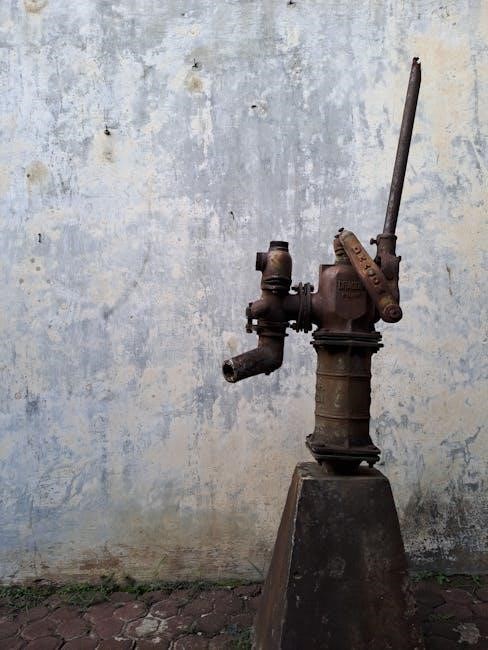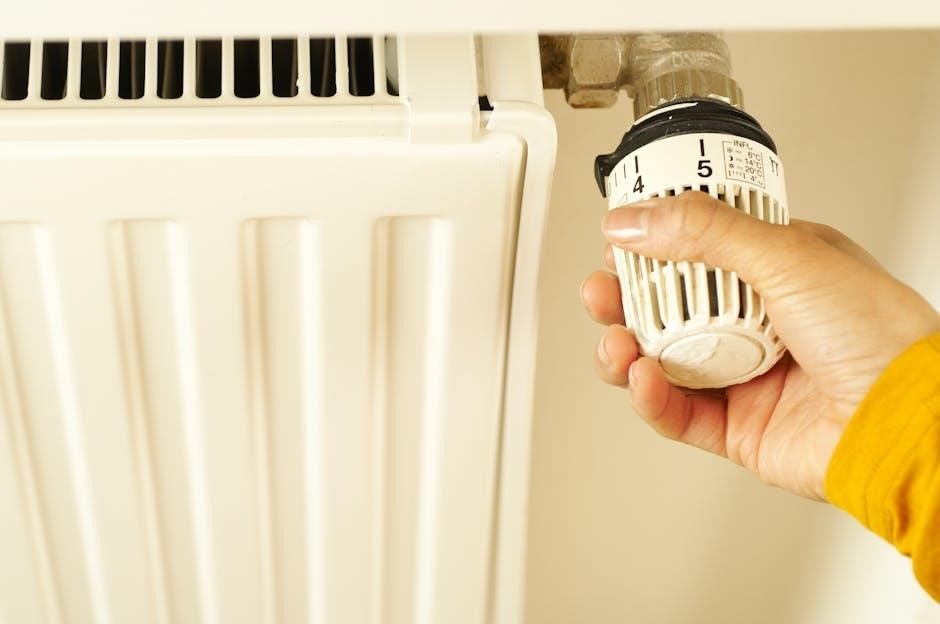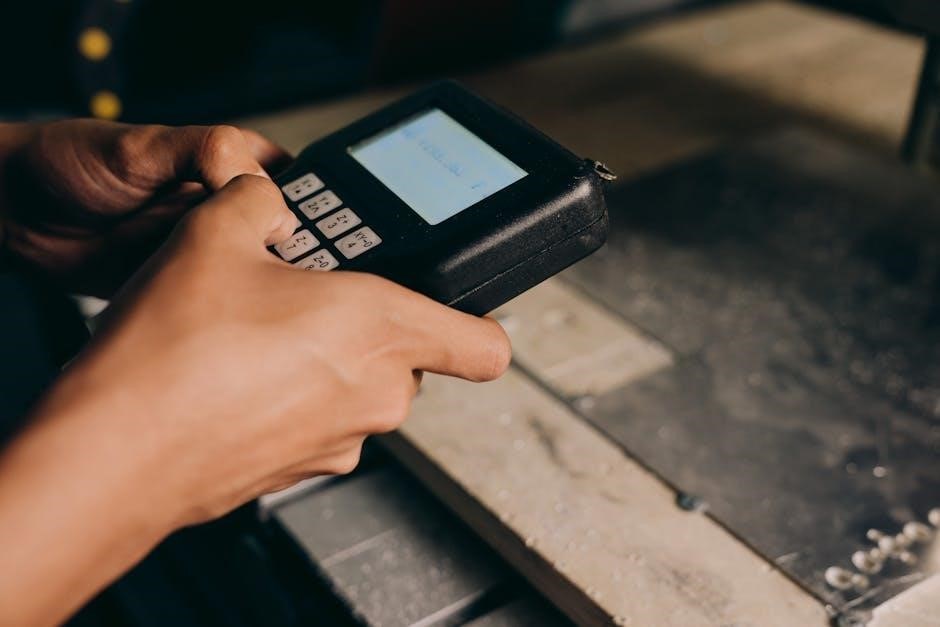
VTech VM819 Manual: A Comprehensive Guide
Welcome! This comprehensive guide details the VTech VM819 video baby monitor, offering essential safety instructions, setup procedures, and troubleshooting steps for optimal use.
Explore features like two-way talk, temperature monitoring, and PTZ control, alongside advanced settings and support resources, ensuring peace of mind for you and your little one.
The VTech VM819 Video Baby Monitor is designed to provide parents with peace of mind, offering a reliable and secure way to stay connected with their baby. This digital video monitor features a large color LCD screen, delivering a clear view of your little one, even in low-light conditions thanks to its advanced night vision capabilities.
Beyond visual monitoring, the VM819 boasts two-way talk functionality, allowing you to soothe your baby remotely with your voice. It also includes temperature monitoring, ensuring a comfortable environment for your child. The VM819-2 model specifically introduces a unique PATROL mode, enhancing monitoring flexibility.
This guide will walk you through the setup process, explain the various features, and provide troubleshooting tips to ensure you get the most out of your VTech baby monitor. Refer to the full user manual available online for detailed instructions and support.
What’s Included in the Box
Upon opening your VTech VM819 package, please verify that all components are present. You should find one Baby Unit, responsible for capturing video and audio from your baby’s room, and one Parent Unit, the portable display allowing you to view and interact.
The box also contains the necessary power adapters for both the Baby and Parent Units, enabling continuous operation. Additionally, you’ll receive a Quick Start Guide to assist with initial setup, and a safety instruction booklet outlining important precautions.
Depending on the model (VM819 or VM819-2), the included items may vary slightly. Please retain all packaging and documentation for future reference or potential warranty claims. Visit VTech’s support website to download the full user manual for a comprehensive list and detailed diagrams.
Important Safety Instructions
Safety is paramount when using the VTech VM819 video baby monitor. Always follow these instructions to ensure safe operation. Keep the Baby Unit and power cords out of reach of children to prevent choking hazards or electrical shock.
Do not use the device near water or expose it to excessive moisture. Only use the provided power adapters; using incompatible adapters may cause damage or pose a fire risk. Regularly inspect the cords for damage and discontinue use if any are found.
This device is intended for indoor use only. Avoid placing the Baby Unit directly in sunlight or near heat sources. Refer to the full user manual for detailed safety guidelines and warnings regarding proper handling and maintenance of your VTech monitor.

Setting Up Your VTech VM819
Begin setup by connecting the Baby and Parent Units to power. Ensure proper placement for optimal viewing and audio monitoring, then charge the batteries fully.
Connecting the Baby Unit
Positioning the Baby Unit is crucial for effective monitoring. Place it within range of the Parent Unit, ideally 6-8 feet from the crib, ensuring a clear view of your baby. Avoid placing it directly over the crib, as this could create a hazard.
Power Connection: Connect the provided AC adapter to the Baby Unit and plug it into a working electrical outlet. Verify the power LED illuminates, indicating it’s receiving power. Ensure the power cord is securely connected and out of reach of children.
Initial Setup: Upon powering on, the Baby Unit will automatically attempt to pair with the Parent Unit. If pairing fails, refer to the ‘Pairing Issues’ section for troubleshooting. The Baby Unit requires a constant power source for continuous operation; battery power is not supported for the Baby Unit itself.
Safety Note: Never attempt to disassemble or modify the Baby Unit. This could result in electric shock or damage to the device. Always follow the safety instructions outlined in the full user manual.
Connecting the Parent Unit
The Parent Unit operates on battery power or AC adapter. For initial use, it’s recommended to fully charge the battery (see ‘Charging the Batteries’ section). Power on the Parent Unit by pressing and holding the power button until the LCD screen illuminates.
Pairing Process: The Parent Unit should automatically pair with the Baby Unit during initial setup. If pairing is unsuccessful, manually initiate pairing mode by following the instructions in the full user manual. Ensure both units are within close proximity during pairing.
AC Adapter Connection: Connect the provided AC adapter to the Parent Unit and plug it into a working electrical outlet for continuous operation. The battery will continue to charge while connected to AC power.
Volume Adjustment: Use the volume control buttons on the side of the Parent Unit to adjust the audio level to your preference. Ensure the volume is audible but not disruptive.
Charging the Batteries
To ensure uninterrupted monitoring, keep the Parent Unit battery charged. Connect the provided AC adapter to the charging port on the unit and plug it into a functioning electrical outlet. The Battery LED indicator will illuminate, signifying charging is in progress.
A full charge typically takes approximately 10-12 hours. The LED will either remain solid or change indication (refer to the full user manual for specific LED behavior) when fully charged.
For optimal battery life, avoid prolonged periods of continuous use solely on battery power. It’s recommended to connect the unit to AC power when not actively monitoring.
The battery performance may degrade over time. If you notice a significant reduction in battery life, consider replacing the battery with a compatible one (refer to the manual for specifications).

Understanding the VM819 Features
Explore the VM819’s capabilities! Enjoy features like a clear LCD screen, two-way talk, temperature sensing, remote PTZ control, and reliable night vision for comprehensive monitoring.
LCD Screen Display
The VTech VM819 boasts a high-resolution LCD screen providing a clear, detailed view of your baby’s room. This allows for easy visual monitoring, even in low-light conditions. The screen displays crucial information, including the video feed, temperature readings, and battery status of both the parent and baby units.
You’ll also notice indicator icons displaying power status, connection strength, and whether the two-way talk function is active. For VM819-2 models, a specific icon illuminates when PATROL mode is engaged. The screen’s brightness is adjustable to suit different lighting environments, ensuring optimal visibility without causing eye strain. Regularly check the display for any error messages or alerts, as these can indicate potential issues requiring attention. The screen automatically activates when motion is detected, providing instant reassurance.
Two-Way Talk Functionality
The VTech VM819’s two-way talk feature allows you to remotely soothe your baby with the sound of your voice. Simply press the talk button on the parent unit, and your voice will be transmitted through the baby unit’s speaker. This can be incredibly reassuring for both you and your little one, especially when you’re unable to be physically present in the room.
The clarity of the audio transmission ensures your baby can clearly hear your voice. This feature is particularly useful for calming a fussy baby or offering verbal reassurance. Adjust the volume on both the parent and baby units to achieve a comfortable listening level. Remember to speak clearly and calmly when using the two-way talk function for optimal effectiveness. It’s a convenient way to maintain a connection, even from a distance.
Temperature Monitoring
The VTech VM819 incorporates a temperature monitoring system, displaying the room temperature on the parent unit’s LCD screen. This feature allows you to ensure your baby’s environment remains comfortable and safe. Maintaining an optimal temperature is crucial for your baby’s well-being, preventing overheating or chilling.
The temperature is displayed in Fahrenheit (°F) or Celsius (°C), selectable within the settings menu. You can set high and low-temperature alerts, which will notify you if the room temperature falls outside your pre-defined range. This provides an added layer of security, allowing you to promptly address any temperature fluctuations. Regularly check the temperature display to proactively maintain a comfortable nursery climate for your little one.
Pan, Tilt, and Zoom (PTZ) Control
The VTech VM819 offers remote Pan, Tilt, and Zoom (PTZ) control, allowing you to adjust the camera’s viewing angle directly from the parent unit. This feature enables you to remotely scan the entire nursery without physically moving the baby unit. Use the directional buttons on the parent unit to pan the camera left and right, tilt it up and down, and zoom in for a closer look at your baby.
PTZ control provides flexibility in monitoring your child’s movements and ensuring they are safely positioned within the crib. The range of pan and tilt is extensive, offering a wide field of view. Utilize the zoom function to observe details more clearly. This remote control capability minimizes disturbance to your baby, allowing for discreet and convenient monitoring.
Night Vision Capabilities
The VTech VM819 is equipped with automatic infrared (IR) night vision, enabling clear monitoring of your baby even in complete darkness; When the ambient light dims, the IR LEDs activate automatically, providing a black and white image on the parent unit. This allows you to continue monitoring your baby without disturbing them with a bright light.
The night vision range is substantial, ensuring a clear view across the nursery. The image quality in night vision mode is optimized for detail and clarity, allowing you to easily check on your baby’s well-being. You don’t need to manually enable or disable night vision; the system handles it seamlessly. This feature provides peace of mind, knowing you can always see your baby, day or night.

Troubleshooting Common Issues
Encountering problems? This section provides solutions for frequent concerns like no picture, poor audio, battery issues, and pairing difficulties with your VTech VM819;
No Picture on Parent Unit
Experiencing a blank screen on your parent unit? Several factors could contribute to this issue. First, ensure the baby unit is powered on and within range of the parent unit. Verify the power adapter is securely connected to both the unit and a working electrical outlet.
Check the volume control; sometimes, a very low volume setting can appear as a lack of picture. Confirm the camera lens isn’t obstructed by anything. Attempt a reset of both the baby and parent units by disconnecting power, waiting briefly, and reconnecting.
If the problem persists, try re-pairing the units following the instructions in the setup guide. A weak battery in the parent unit can also cause display issues; ensure it’s adequately charged. Finally, consult the VTech support website for further assistance and potential firmware updates.
Poor Audio Quality
Is the sound from your VTech VM819 unclear or distorted? Begin by checking the volume levels on both the baby and parent units, ensuring they aren’t set too low or excessively high. Confirm the microphone on the baby unit isn’t blocked by any objects or coverings.
Interference from other electronic devices can sometimes degrade audio quality; try moving the baby unit away from potential sources of interference like microwaves or wireless routers. Adjust the VOX sensitivity – a setting too high might pick up background noise.

Ensure a stable connection between units by verifying they are within range. A reset of both units can often resolve temporary glitches. If issues continue, explore the VTech support website for troubleshooting tips and potential firmware updates that may improve audio performance.
Battery Life Concerns

Experiencing shorter than expected battery life with your VTech VM819? Remember that battery performance diminishes with age and usage. Keep the parent unit connected to AC power whenever possible to minimize battery drain and maintain a full charge.
Lowering the screen brightness on the parent unit significantly extends battery life. Disable features like continuous audio monitoring if not needed, as they consume more power. Avoid extreme temperatures, as they can negatively impact battery performance.
Check the battery LED indicator; a flashing light signals low battery. If the battery life remains unsatisfactory, consider contacting VTech support to inquire about battery replacement options or potential issues with the unit.
Pairing Issues Between Units
Encountering difficulty pairing your VTech VM819 baby and parent units? First, ensure both units are within range and powered on. Restart both the baby and parent units – this often resolves temporary connection glitches.
Refer to the user manual for the specific pairing procedure; it typically involves pressing and holding the pairing button on both units simultaneously. Ensure no other VTech baby monitors are nearby, as they can interfere with the pairing process.

If pairing repeatedly fails, try resetting both units to their factory defaults (consult the manual for instructions). Contact VTech support if the issue persists, providing your model number for assistance. A stable connection is crucial for reliable monitoring.

Advanced Features & Settings
Unlock the full potential of your VM819! Explore PATROL mode (VM819-2), customize volume levels, select soothing lullabies, and fine-tune VOX sensitivity for personalized monitoring.
PATROL Mode (VM819-2 Only)
Exclusive to the VM819-2 model, PATROL mode offers automated scanning of the baby’s room, providing continuous monitoring without manual panning and tilting. When activated, the baby unit will automatically sweep across the room at pre-set intervals, displaying each position on the parent unit sequentially.
This feature is incredibly useful for larger nurseries or when you want a broader view of the environment. The display on the parent unit will indicate when PATROL mode is active. You can easily toggle this mode on or off through the settings menu on the parent unit. It’s designed to offer enhanced surveillance and reassurance, ensuring you don’t miss a moment, even when you’re not actively watching the screen.
Remember to consult the full user manual for detailed instructions on configuring and utilizing the PATROL mode effectively.
Volume Control & Settings
Adjusting the audio levels on your VTech VM819 is straightforward, allowing you to customize the sound to your preference and environment. The parent unit features dedicated volume up and down buttons for immediate adjustments. You can also access more granular control through the settings menu, offering precise volume level selection.
Beyond basic volume, the VM819 allows you to mute the audio completely for silent monitoring. Additionally, explore the voice activation settings to automatically adjust the volume based on detected sounds in the baby’s room. This feature helps minimize background noise and focuses your attention on important sounds like your baby’s cries.
Refer to the full user manual for a complete understanding of all available volume control options and settings.
Lullaby Selection & Playback
Soothing your baby is easy with the VTech VM819’s built-in lullaby feature. The baby unit allows you to select from a variety of pre-loaded calming melodies, designed to gently lull your little one to sleep. Access the lullaby menu through the parent unit’s settings, where you can preview and choose your preferred tunes.
You can control the lullaby playback remotely from the parent unit, adjusting the volume to a comfortable level. The system also offers a timer function, allowing you to set a duration for the lullaby to play before automatically turning off. This feature is perfect for establishing a consistent bedtime routine.

Explore the full user manual for a complete list of available lullabies and detailed instructions on playback control.
VOX Sensitivity Adjustment
Voice Activation (VOX) on the VTech VM819 intelligently monitors the nursery sound levels. Adjusting the VOX sensitivity allows you to customize how the parent unit responds to sounds, conserving battery life and minimizing unnecessary alerts. A higher sensitivity setting will activate the parent unit with even quiet noises, while a lower setting requires louder sounds.
Access the VOX settings through the parent unit’s menu. Experiment with different levels to find the optimal balance for your environment. Consider factors like ambient noise and your baby’s typical sound patterns. Proper VOX adjustment ensures you’re alerted to important sounds without constant activation from background noise.
Refer to the full user manual for detailed guidance on VOX level selection and troubleshooting.

Resources & Support
Need help? Access the complete VTech VM819 user manual online, explore FAQs, and visit the official VTech support website for troubleshooting and assistance.
Downloading the Full User Manual
Accessing the complete VTech VM819 manual is simple and provides in-depth information beyond this quick guide. VTech offers a downloadable PDF version directly from their support website. This comprehensive document covers every aspect of your video baby monitor, from initial setup and feature explanations to detailed troubleshooting steps and safety precautions.
You can easily find the manual by visiting the VTech support page and entering your model number – VM819 – into the search bar. The full manual includes detailed diagrams, expanded explanations of each function, and specific guidance for resolving potential issues. Having the complete manual readily available ensures you can maximize the benefits of your VTech baby monitor and address any questions that may arise during use. It’s a valuable resource for optimal performance and peace of mind.
VTech Support Website & FAQs
VTech’s dedicated support website is a valuable resource for VM819 users seeking assistance. The website provides a wealth of information, including frequently asked questions (FAQs) addressing common setup issues, operational queries, and troubleshooting scenarios. You can quickly find answers to many questions without needing to contact support directly.
Beyond the FAQs, the VTech support portal offers access to downloadable manuals, software updates (if applicable), and helpful video tutorials. To efficiently locate relevant information, simply enter your VM819 model number into the search function. If you require further assistance, the website also provides contact information for VTech’s customer support team, allowing you to reach out via phone or email. Utilizing these resources ensures a smooth and satisfying experience with your VTech video baby monitor.



























































